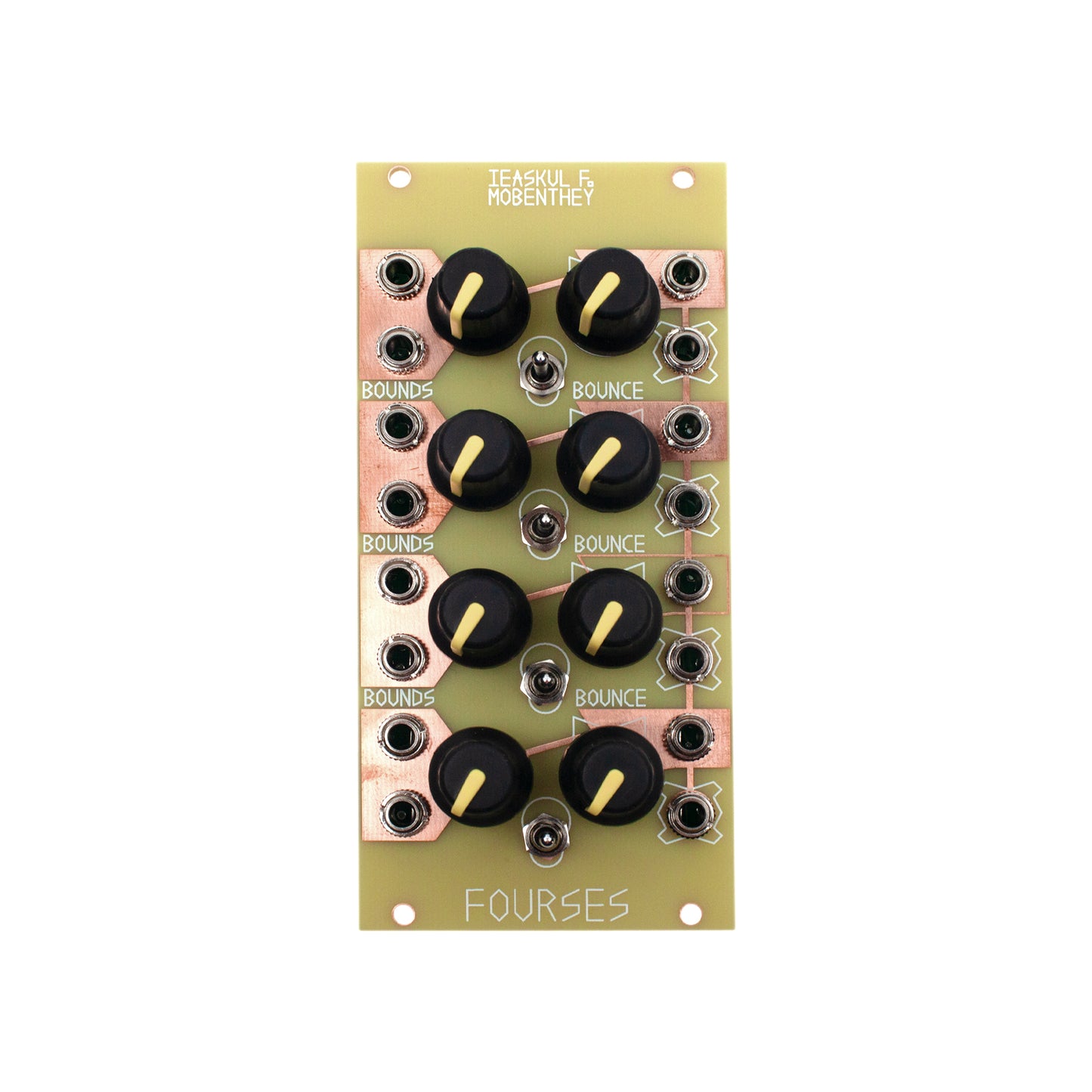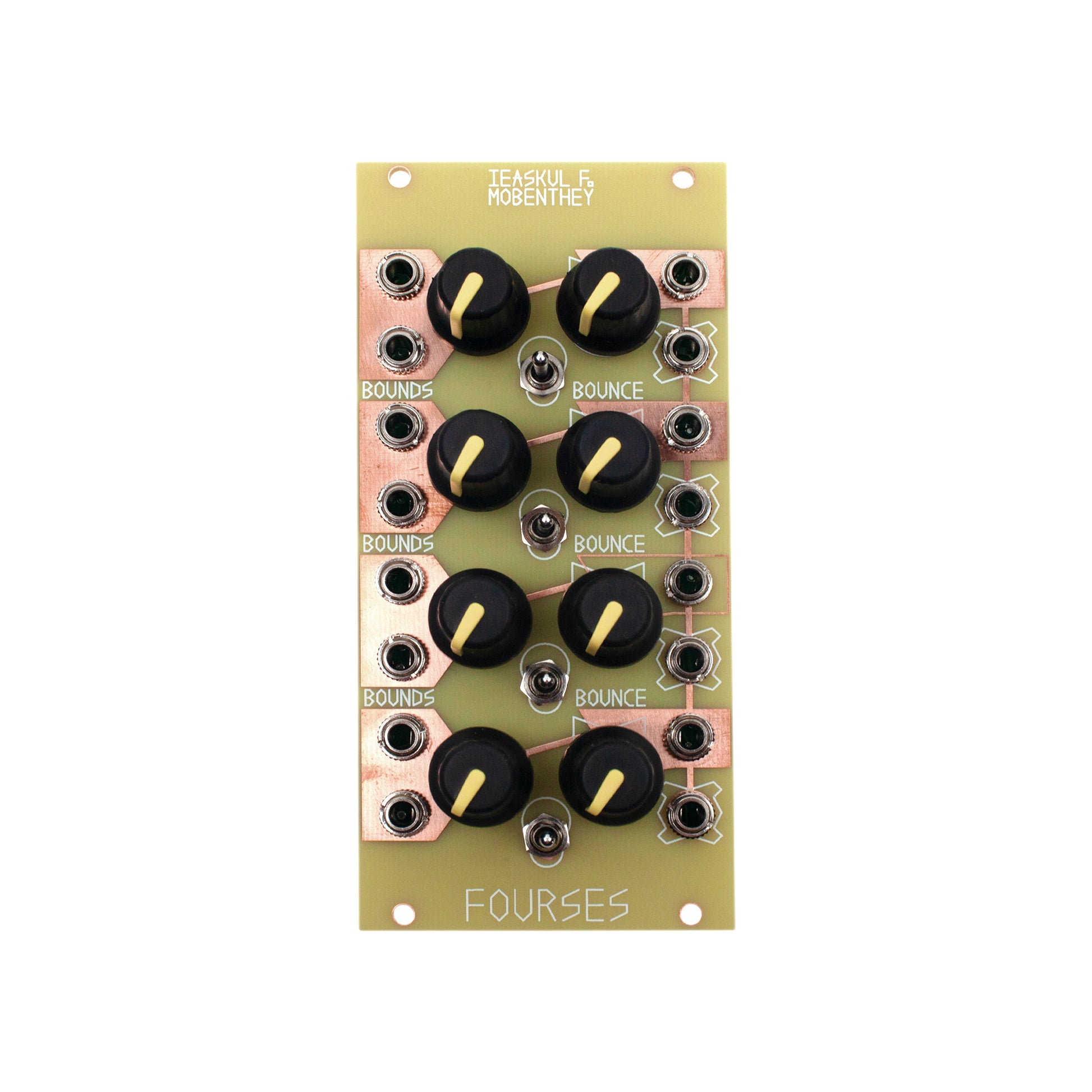Ieaskul F. Mobenthey
Fourses
Fourses
Impossibile caricare la disponibilità di ritiro
In stock
Eurorack format from Ciat-Lonbarde
Text by Peter Blasser
The Fourses module consists of four bounds/bounce oscillators, stacked on top of each other so that their bounds are mutual. Imagine four bouncy balls in a greased perspex tube only wide enough to permit them to travel along it. They bounce off of each other in the tube, and generate intricate but inter-related chaotic outputs. Each bouncy ball has the requisite basis and attenuverter knobs, and bounds inserts, control input, and triangular output.
Fourses is a 12HP Eurorack module that runs on +12 and -12 volts. Attach power connector positive to “+” and negative to “-”. Failure to follow proper power polarity will result in instant destruction of unit.
Looking at the front panel of Fourses, note that inputs are marked by copper fill. The four operators are exactly the same in appearance. The bounds of any operator are dictated by the ones immediately above and below, except for the very top and bottom operators; the top upper bound is set to eight volts, and the bottom lower bound to negative eight volts. The bounds of any operator, however, have inserts that you can use to manually set a boundary to whatever voltage you wish. This may introduce Ieaskul's masthead, the paradox wave, that comes about when a lower bound is greater than an upper bound, causing the oscillator to go into hyper oscillation since it cannot rest in any stable zone.
Connected to the bounds inserts area, there is a rate knob that acts in a special, Fourses-like way: knob in middle causes the up- and down- slopes to be equally fast, and the operator will bounce easily; turn the knob clockwise and it will have a very slow down-slope and a fast up-slope, counter-clockwise is the opposite. The philosophical reasons for such a knob came about when testing the original fourses; control of slope symmetry is just as important as, or perhaps more important than, control of frequency in Fourses. The control input, with associated attenuverter also controls frequency and symmetry in the same way. An attenuverter works like this: at noon the modulations are nulled out, they have no effect; clockwise from there they increase in intensity, with positive input meaning “more”; to the counter-clockwise direction, modulations increase as well, but with
negative input meaning “more”. This knob is essential to controlling how much, and in which direction, your modulations apply.
The “position out” can hardly be called “triangle out” anymore, but it is the same electronically as would a triangle output- a reading of the current position of each bouncy ball.
For each operator there is a range switch. When in middle position, the operator runs at a standard audio rate. Pointing downward is a low audio rate, and pointing upwards is a definite CV, lowest rate.
History of Fourses
Fourses was originally released by Ciat-Lonbarde in kit format, around the time of the Bush-years. It had two of the “greased perspex tube” formations, plus some interstitial circuitry called the “intersexon”. Ieaskul is considering putting out an expansion module to create this intersexon between two Fourses modules, but you could probably cook up a recipe that would be very similar with stock Eurorack sample-and-hold modules; simply trigger a sample of one Fourses by another Fourses, and make these step-like signals available again for modulation. The thing that is hard for a Eurorack system to mimic, is how the intersexon used current mirrors on the outputs; outputs thus would mix in a unique, non-ohmic melange of competing current sources. Eurorack, and the modular philosophy in general, does not condone modulation by current vector, only preferring outputs to be voltage in series with a 10k resistor. Actually current mixing could be an interesting route to explore for modulator-masters, but it is a subtle region. It was only brought about because the Fourses was a touchable instrument, having about 156 brass nodes sticking up out of a wooden case, that could be patched by both wire or flesh, or even a living worm. It was part of a general exploration of mixing signals to use current as one source of output electrons.
Another inspiration was the circuit-bending movement, and the use of innards of circuits, exposed to musical touch. Thus, Fourses was an instrument designed to be bent, and it did this by bringing the interior, “soft-like” parts of each oscillator out. The two most important would be called the “capacitor tank,” and the “hysteresis node,” which correspond directly to the bounce/bounds dialectic as well as that of the triangle/square. You see any triangle oscillator has an accumulator of analog slope, using a capacitor to make angled segments; and a bounds tester, comparing against a fixed (or not so fixed) measure. Since the capacitor tank deals mostly in current anyway, this was a good tip-off to make current-nodes in the overall design.
In bringing back the Fourses, ten years later, all these touch-operable features were explored in numerous prototype paper-circuits, and they worked as in the original. However, the Fourses modular does not include such extended touch-features, because it is a redundancy on top of the central concept; Fourses itself is a modeling of a sort of inter-related touch web, by having each oscillator “touch” the other. It is a morphic resonance to put a “touch” oscillator inside a “touch” case, but perhaps the use of the Fourses primitive as source of chaos could be distilled down into a small form factor with complete voltage control and range switches, to interface and scramble all sorts of other modules with its manifold outputs. Perhaps in the future we could bring back the touch-Fourses, but Ieaskul is confident that fitting it into the Eurorack standard is a happy compromise to bring its unique sounds and gestures to “Europe”.
trying to keep with original idea:
-
A sound of closely tuned oscillators bouncing off of each other, chaotic fuzz. If the operators share a similar frequency then they become indistinguishable, like bosons.
-
far tuned oscillators including low frequency ones brings out grains, striations, or beats in the texture. This is why tuning symmetry and frequency at the same time is important: slopes pointing away from each other create harder boundaries.
-
intersexon provides a counterpoint, or better yet “motif b” for the instrument. Now this is out sourced to the Eurorack consortium.
-
sandrodes are nodes that are highly touchable. they are hard to implement because they represent both input and output: the instrument has to be tied up, but have a highly sweet “ground state”... it is the action of crossing all these nodes that changes its state, ties it up more, making touch sensitivity, wireability...
-
“goal based design” --- tansas city station --- transmitter > noise > receiver


